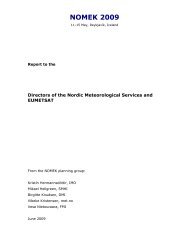International Symposium on Mitigative Measures against Snow ...
International Symposium on Mitigative Measures against Snow ...
International Symposium on Mitigative Measures against Snow ...
Create successful ePaper yourself
Turn your PDF publications into a flip-book with our unique Google optimized e-Paper software.
<str<strong>on</strong>g>Internati<strong>on</strong>al</str<strong>on</strong>g> <str<strong>on</strong>g>Symposium</str<strong>on</strong>g> <strong>on</strong> <strong>Mitigative</strong> <strong>Measures</strong> <strong>against</strong> <strong>Snow</strong> Avalanches<br />
Egilsstaðir, Iceland, March 11–14, 2008<br />
The percepti<strong>on</strong> of risk by the public can determine the extent to which they will accept<br />
the planned level of the approach set by the authorities.<br />
Society’s tolerance levels tend to fluctuate with the occurrence of disasters impacts. A serious<br />
catastrophe that causes widespread casualties and losses will create an upsurge of opini<strong>on</strong> in<br />
favour of renewed mitigati<strong>on</strong> effects. It will thus reduce the tolerance level. But a l<strong>on</strong>g and<br />
peaceful period may allow other priorities to replace hazard mitigati<strong>on</strong> and disaster<br />
preparedness, and thus increase the tolerance level (Alexander, 2000).<br />
This tendency was clear during Parliamentary debate about snow avalanche disasters in<br />
Iceland, first in 1974, then in 1983, and again in 1994-5 (Parliamentary debate 1974/-<br />
1983/1994-5).<br />
3. THE COLLABORATION OF CIVIL PROTECTION AND THE<br />
METEOROLOGICAL OFFICE<br />
Following a snow avalanche disaster in the town of Neskaupstaður 1974, it was clear that<br />
increased work in avalanche risk research was an urgent requirement, and an amendment was<br />
needed in the legislati<strong>on</strong>. M<strong>on</strong>itoring, risk assessments, data gathering and research were<br />
incomplete. Debate in the Parliament demands improvement. In 1978, the Prime Minister´s<br />
Office assigned the matter of snow avalanche preventi<strong>on</strong> to the Ministry of Communicati<strong>on</strong><br />
which gave the Meteorological Office the project. In 1979−80 a Parliament resoluti<strong>on</strong><br />
proposed “that of all natural disasters in Iceland mitigati<strong>on</strong> for snow avalanches could be the<br />
most successful of all because of their specific locati<strong>on</strong> and their meteorological nature that is<br />
easy to m<strong>on</strong>itor” and “<strong>Mitigative</strong> measures are the <strong>on</strong>ly l<strong>on</strong>g lasting investment and the most<br />
profitable” (P.r. 1980-03-18). Still there was no permanent acti<strong>on</strong> taken by the Parliament.<br />
After a snow avalanche disaster in the village of Patreksfjordur in 1983, the government<br />
decided to form a snow avalanche expert committee to coordinate this work, and to try to<br />
prevent accidents due to snow avalanches and landslides. The committee proposed the<br />
strengthening of the work of the Meteorology Office and the Civil Protecti<strong>on</strong> Unit (AVRIK)<br />
and gave the local government increased authority. Then the work of the committee was<br />
terminated due to savings in the nati<strong>on</strong>al ec<strong>on</strong>omy. The <strong>on</strong>ly legislati<strong>on</strong> until 1985 that<br />
stipulated preparedness and resp<strong>on</strong>se to natural disaster was in the Civil Protecti<strong>on</strong> Act and<br />
the Act <strong>on</strong> Natural Catastrophe Insurance (52/1975 article 19). The legislati<strong>on</strong> for the<br />
Meteorological Office 1958 stipulated warning <strong>against</strong> harmful weather in article 4. The first<br />
law <strong>on</strong> preventive measures <strong>against</strong> snow avalanches took effect in 1985.<br />
One key provisi<strong>on</strong> in the 1985 legislati<strong>on</strong> was the role of the Civil Protecti<strong>on</strong> in the risk<br />
assessment process, classificati<strong>on</strong> and utilizati<strong>on</strong> of hazard z<strong>on</strong>es while the Meteorological<br />
Office focus was <strong>on</strong> m<strong>on</strong>itoring, data gathering, research and warnings. Individual local<br />
government and the Civil Protecti<strong>on</strong> had to give the risk assessment their c<strong>on</strong>sent and then the<br />
Ministry of Social Affair made the final decisi<strong>on</strong>. Local governments could make<br />
recommendati<strong>on</strong> for structural barriers and planning in their community but the Civil<br />
Protecti<strong>on</strong> and the Ministry of Social Affairs had to agree. The warning procedure became<br />
collaborati<strong>on</strong> between the Icelandic Civil Protecti<strong>on</strong>, the Icelandic Meteorological Office and<br />
the Civil Protecti<strong>on</strong> Committees in each district (Hilmarss<strong>on</strong>, 1999).<br />
Before the snow avalanche disasters in the villages of Súðavík and Flateyri in 1995, it was<br />
again clear that more effective measures in avalanche preventi<strong>on</strong> preparedness and resp<strong>on</strong>se<br />
were needed. Increased amendments were made; the snow avalanche preventive measures<br />
184 N<strong>on</strong>-structural mitigati<strong>on</strong> in areas of high snow avalanche frequencies in Iceland











